How to green up your winter garden in central Texas
Texas dwarf palmetto (Sabal minor), foxtail fern (Asparagus densiflorus ‘Meyersii’), heartleaf skullcap (Scutellaria ovata), sparkler sedge (Carex phyllocephala ‘Sparkler’), and bamboo muhly (Muhlenbergia dumosa) add plenty of greenery to the winter garden.
Audrey, a regular reader of Digging, recently asked me how to plant for winter greenery, explaining that her garden needed some green for the off-season. “I would love to see a picture of an area of your garden in full bloom and the exact same shot in the winter,” she wrote. What a great idea! Not that my garden is totally fab in winter or anything, but I do have quite a lot of evergreen interest, plus a few other tricks that help liven up the winter garden here in Austin.
I will point out that my garden is not particularly flowery. There are three reasons for this. One, my garden is fairly shady. Two, I love the architectural plants of the Southwest, and they are essentially evergreen shrubs. Three, I planted this garden to be low-maintenance, and that means more evergreens and ornamental grasses and fewer flowering perennials and annuals.
That adds up to a garden that doesn’t go through dramatic seasonal changes, and I’m OK with that. I do still enjoy smatterings of flowers throughout the growing season, as well as berries, bulbs, a little fall color, and the unfurling of bright-green leaves in the spring. Bees, butterflies, and other pollinators visit my garden, and I see lots of birds, which goes to show that even a largely evergreen garden, planted diversely with plenty of cover, nesting material, and seed and fruit sources, can be a wildlife habitat.
OK, let’s look at a few wide-shot views of my garden in mid-winter, paired with similar views from a more flowery season.
Today. (The garden in the foreground belongs to my neighbor, though I planted and help maintain it, and I frequently blog about it as if it were mine. Hi, Donna!)
Early October. Salvia greggii and Salvia leucantha brighten up this bed with flowers in spring and fall, and most other plants are a brighter green. In winter, though the S. leucantha shrivels away, the Salvia greggii remains green. Mexican feathergrass (Nassella tenuissima) and Gulf muhly (Muhlenbergia capillaris) turn tawny, but they’re still there, as are evergreen (or everblue?) Agave ovatifolia, red yucca (Hesperaloe parviflora), and bamboo muhly (Muhlenbergia dumosa).
Today
Mid-October. Not much difference, really. It’s all a bit more faded and tawny, and the copper canyon daisy (Tagetes lemmonii) at left is frost-shriveled now. However, this is a very evergreen bed. You can get color from evergreen plants too, as shown by the yellow-striped ‘Color Guard’ yucca, the blue-green gopher plant (Euphorbia rigida), and the silver ‘Powis Castle’ artemisia.
Today
Early March. Again, pretty similar thanks to a mass planting of Mexican feathergrass and prickly pear. Even the little four-nerve daisy (Tetraneuris scaposa) is still blooming sporadically. Springtime adds the chartreuse flowering of gopher plant (Euphorbia rigida) to the mix. You’ll notice I added a potted Agave lophantha for vertical interest since the spring. Potted evergreens are a great way to get additional winter greenery and to make a focal point of it.
Another example of winter interest in a pot: ‘Color Guard’ yucca in a blue glazed container, with foxtail fern at its feet.
Today
Late March. Pulling back a bit, you see globemallow (Sphaeralcea ambigua) in full bloom. This heat-loving plant flowers spring through fall but shrivels up in winter. The evergreen Arizona cypress ‘Blue Ice’, bamboo muhly, gopher plant, and butterfly vine (Mascagnia macroptera) add up to plenty of winter greenery.
Today
Late May. A tighter image, with purple coneflowers (Echinacea purpurea) and ‘Peter’s Purple’ monarda in bloom in beds on either side of the pond. The pond will also have been blooming with water lilies. Look back up at today’s image and you’ll actually see two hangers-on purple coneflowers, but the other flowering plants are dormant. But what carries this area through winter is the structure of the stock tank, shed, and disappearing fountain (in the foreground), the colorful shed doors and fountain, the reflective quality of the water in the pond, ‘Winter Gem’ boxwoods marking the path “doorways” all around the pond, ‘Color Guard’ yuccas, and Mexican feathergrass. Also, don’t overlook the power of hardscape to give life to your garden in winter. The sunburst path around the pond is a striking feature of this space, all the more noticeable in winter when the garden is quieter.
On the other side of the stock-tank pond, a trio of culvert-pipe planters with squid agaves (A. bracteosa) adds height and texture to the winter garden. Winter-through-spring groundcover heartleaf skullcap (Scutellaria ovata) adds a blue-green carpet at their feet.
Today
Mid-April, when the Aloe saponaria was in bloom. Let’s face it, this raised bed overlooking the pool is all about texture and form, with hits of variegated yellow color, and not about flowers. Even so, the soap aloes bloom a couple of times a year, and in fall oxblood lily bulbs pop up along the edge of the bed, providing a jolt of seasonal color.
Today
Early June. I couldn’t find the same viewpoint for the raised bed containing the ‘Whale’s Tongue’ agave (A. ovatifolia), but you can see from another angle what it looks like in June. Winecup (Callirhoe involucrata) rambles and purple skullcap (Scutellaria wrightii) flowers profusely. Earlier in the season, iris add their ruffled flowers to the mix.
Here then are my tips for greening up your winter garden: add lots of evergreen shrubs, sub-shrubs (like Salvia greggii), and ornamental grasses, especially evergreen ones like bamboo muhly. Add punches of color with cold-hardy potted plants set into your beds and with painted surfaces like sheds, benches, and garden art. And leave frostbitten plants standing through winter, because even tan and brown are colors, and it all adds up to an interesting winter garden.
All material © 2006-2013 by Pam Penick for Digging. Unauthorized reproduction prohibited.


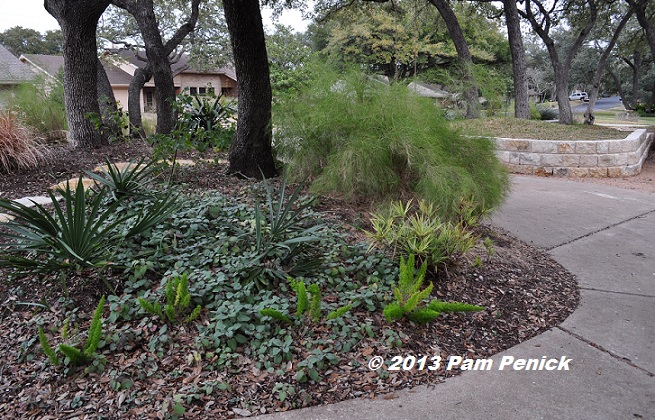
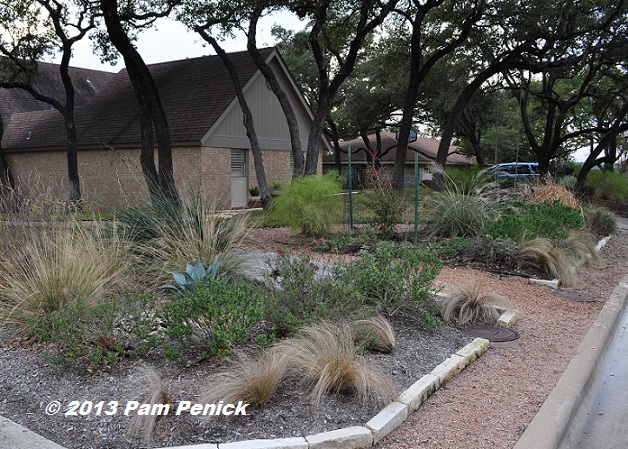
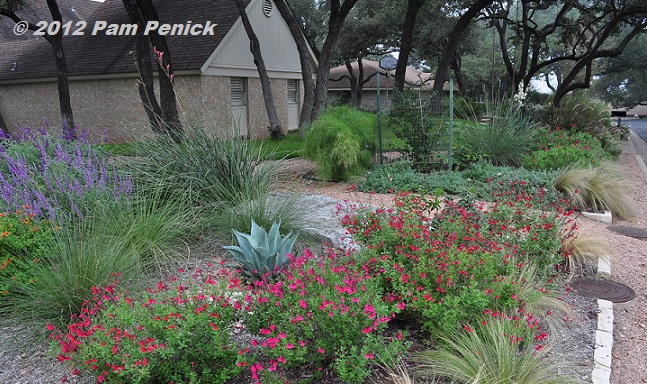
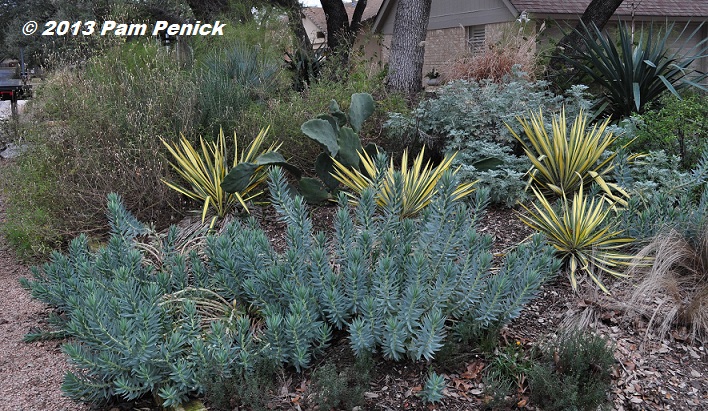
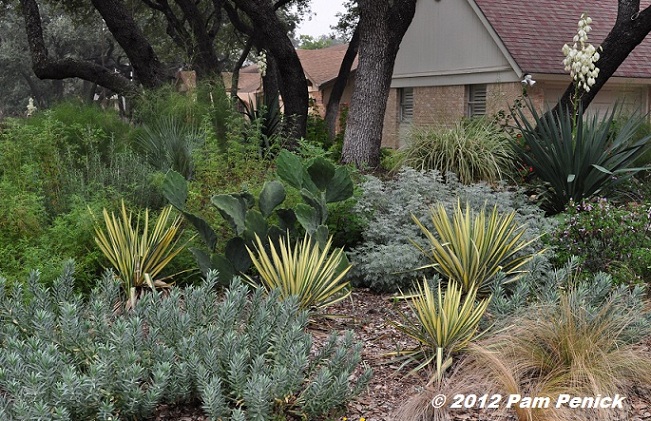
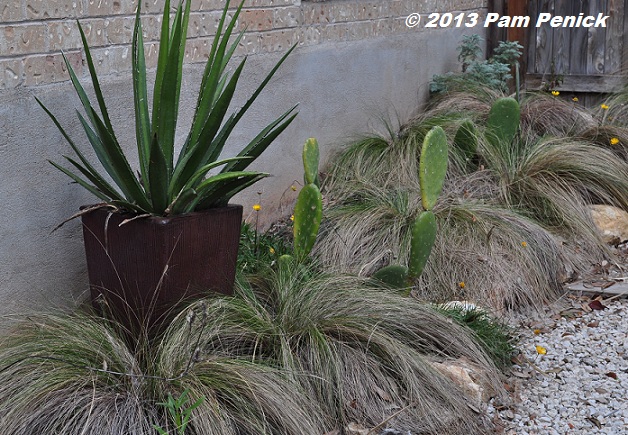
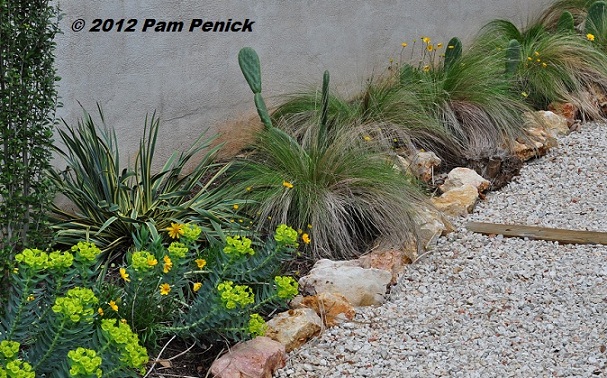
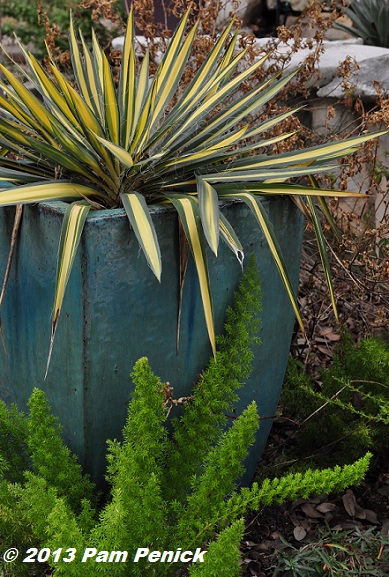
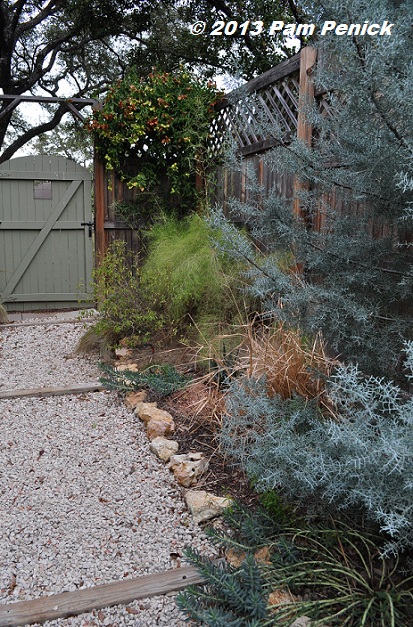
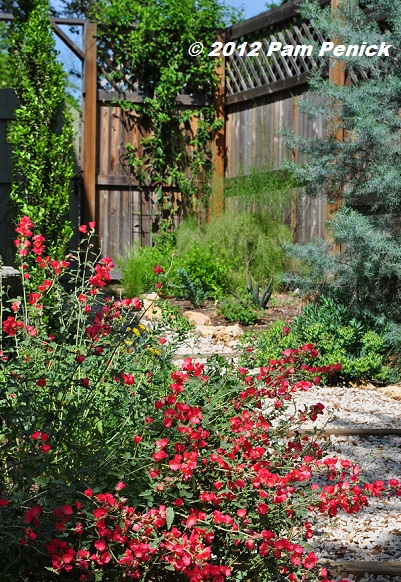
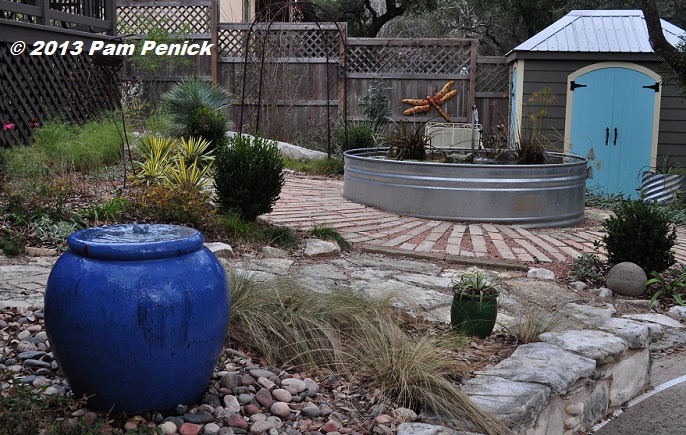
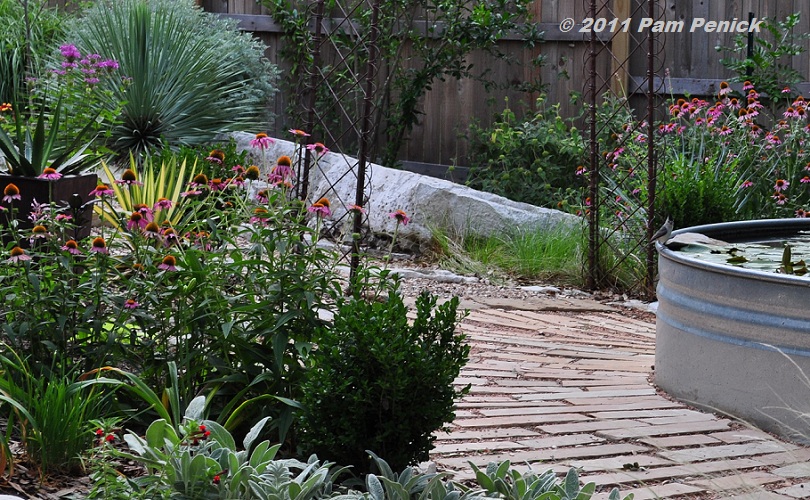
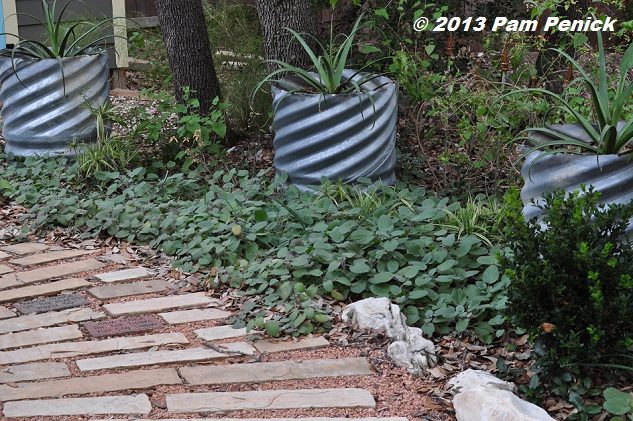
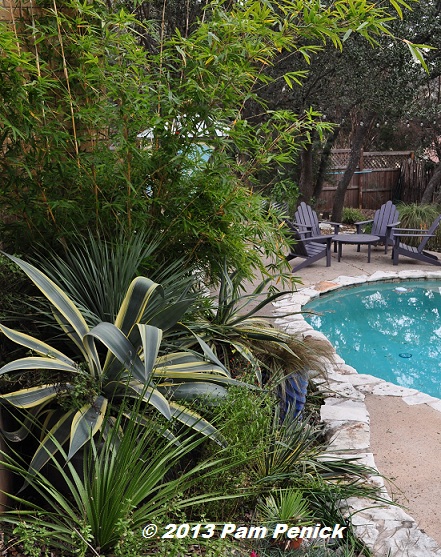
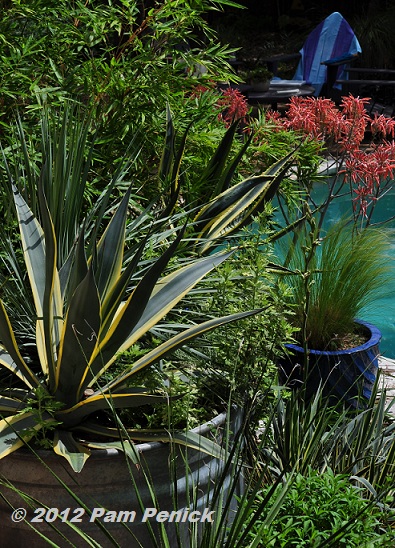
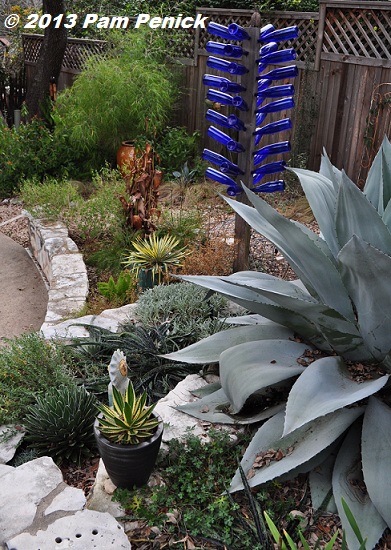
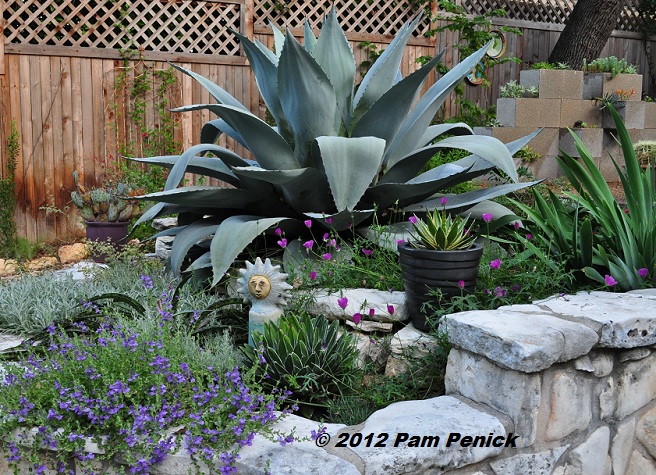
I certainly love a year round garden. Yours looks wonderful in wintertime. One thing I regrettably need to incorporate is more spring/summer colour. My yard looks pretty much the same all year and like you say, I’m okay with that. If everything looked like a dead and dying mess all winter I would be soo very sad. But there is still more room in my yard for a few splashes of reds and oranges and other happy flowers that evoke warmth and sunshine 🙂
It’s easy to tuck flowering plants into a largely evergreen garden, so that should be simple to fix, Louis. I agree about not wanting to see a dead-looking garden in winter but still wanting pops of color, fragrance, and bee- and butterfly-attracting flowers for the other seasons. Maybe you’ll write a post about the flip side: flowering up the evergreen garden! —Pam
Your garden looks beautiful any time of the year Pam. I love seeing all that sculpture in your garden. By that I mean all of those agaves etc that I can’t grow to any size. I love those foxtail ferns too. They are quite expensive around here and have to be brought inside for winter as you can imagine. Some day I might try one.
Agaves do make great sculpture, don’t they? The foxtail fern is one of my favorite groundcovers. It’s slightly cold tender here too, but our generally mild winters don’t faze it. Just the occasional, horrible, deep cold snap. I dislike those. —Pam
Your garden looks great….anytime.
I’ll be doing some rethinking here…again. The deer have been at it again, out front. Seems we’re always ‘re-gardening’ here.
Thanks for some great inspiration.
Those deer do keep you on your gardening toes, don’t they? Happy re-gardening, Linda. —Pam
Now that was an awesome tour Pam! …and a lot of great lessons to be learned. I need more evergreens and more color! I am drooling over your prickly pear and feather grass combo.
That’s a super-easy combo too, perfect for a sunny, dry, neglected side of the house. —Pam
Thank you for your great post! I didn’t know if you honored requests and so glad that you did. I am ready to brighten up my winter garden. How well does the gopher plant grow in full shade?
I liked your idea, Audrey. Thanks for suggesting it. As for the gopher plant, it’ll do fine if you’re talking morning shade and afternoon sun. But generally it prefers full sun. Full shade would probably kill it. Try foxtail fern, river fern, or Texas nolina there instead. —Pam
I don’t have as much evergreenery (?) as you, but one of my favorite times in the garden is when the frostbitten summer bloomers are cut back, leaving exposed the architectural bones of the garden: some evergreen plants, tawny grasses, lots of limestone and mulch.
Evergreenery—I like your new word! I share your appreciation for the quieter, more elemental beauty of winter as well. —Pam
Your gardens look good any time Pam. Just to have a bloom or two in the winter, you might get a Desert Mallow. Both of mine have had a few blooms on them all winter now, even on days with frost. It’s my new most favorite plant I think.
Are you talking about globe mallow, Bob? I have several of those and love them. Yes, they have a few blooms on them even yet. —Pam
Where do you get your culvert pipes from?
I would love to do something like that in my garden but have no idea where to get them!
I searched for them on Craigslist for a while before I found them, Chris. But eventually several sources popped up for culvert-pipe remnants. —Pam
I am also impressed with your garden. I live in Florida and recently found myself attracted to Agave and Cacti. After visiting your site I am on a quest of finding Whale’s Tongue’ agave for myself. Thank You!